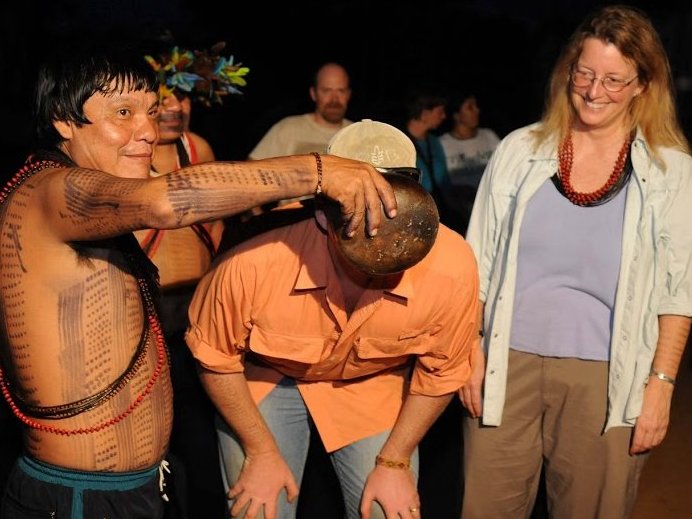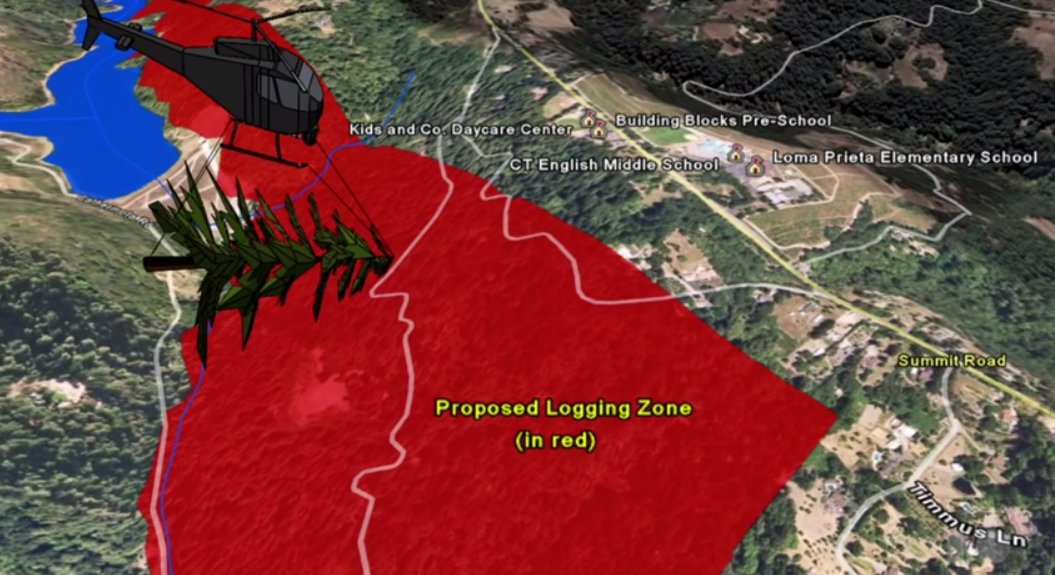 Andrea Ribeiro / GoogleRebecca Moore looks on as a Google colleague becomes an honorary member of the Surui at the end of the ceremony by sipping a a traditional drink.
Andrea Ribeiro / GoogleRebecca Moore looks on as a Google colleague becomes an honorary member of the Surui at the end of the ceremony by sipping a a traditional drink.
They’re standing still as members of the Surui tribe delicately paint elaborate patterns of deep blue dots and lines on their arms, backs, and torsos.Â
The Surui made the ink from a native fruit called the jenipapo and it won’t fade for nearly a month — though they warn the Googlers it will last longer if they’re jealous people.
The ceremony takes place in Lapetanha, a village in the Amazon rainforest, and home of an indigenous people who didn’t have their first contact with outsiders until 1969.Â
The Googlers are there as part of Google Earth Outreach, a team that helps nonprofits and other organizations and communities use Google Earth and Maps tools to attack major environmental and social problems. The Surui used the paint and other rituals to welcome the Goolgers into their village before receiving several days of training on how to use a computer and Google Earth. The people had watched their land get destroyed by the logging and mining industry, and they wanted to learn how to use Google Maps to help.Â
 Andrea Ribeiro / Google Rebecca Moore shows Chief Almir how to use Google Earth tools
Andrea Ribeiro / Google Rebecca Moore shows Chief Almir how to use Google Earth tools
The partnership between Google and the Surui began after the tribe’s chief first discovered Google Earth in an internet cafe and believed that the tool could somehow be used to help his tribe survive. That was only the beginning of an amazing partnership between Google and the Surui tribe that still remains active to this day.Â
Over the last six years, Google Earth Outreach and Google Earth Engine — two initiatives founded and led by a computer scientist named Rebecca Moore — have helped the Surui create cultural maps and record instances of illegal logging on their land. Through Google Earth Engine, they built a real-time alerting system that will notify the tribe whenever suspicious images show up on Google Earth. They can then go investigate and take photos and videos to upload to Google Earth and use to provide as evidence to law enforcement.Â
It’s not just the Surui in Brazil. Google is working with organizations around the world to map out their land and keep track of how things are changing.Â
“I really believe that when people have the information, when everyone in society is empowered with this information, people will make better decisions,” Moore tells us. “I think we can change how we live on this planet. I really believe we can.”Â
To get a better idea of the scope of deforestation in the Amazon, check out this Earth Engine map showing how the area has changed between 1984 through 2012. The dark green stuff that is disappearing here represents a loss of trees.
The partnership with the the Surui is but one of many that have come from the team of slightly more than two dozen Googlers working on Google Earth Outreach and Google Earth Engine.ÂMoore started Outreach in 2005 as a 20% project. She had just started working for Google Earth and had used the then-fledgling product, created through Google’s acquisition of a digital mapping startup called Keyhole, to stop a timber harvesting plan in her Santa Cruz home. After receiving a nearly indecipherable public notice about the plan in the mail, she mapped its specifications on Google Earth, and was able to clearly show other community members and policy makers all the ways the plan would negatively affect their Redwood-laden area. Her presentations galvanized the community against the plan and she actually ended up proving it was illegal.
In 2007, the Mercury News wrote of Moore and her efforts, “While other logging battles feature environmentalists sitting in trees, this one featured Silicon Valley computer programmers sitting at their monitors, studying every acre of the plan.”
Moore decided to spend her 20% time as a liaison to the environmental community. She started getting requests for guidance from organizations like Greenpeace, Sierra Club, Save the Elephants, and others that wanted to learn how to use Google Earth to tell their own stories and empower their causes.
Eventually, demand for help swelled enough that leading Outreach became her full-time position. Google Earth Engine was born out of Google Earth Outreach. Google Earth Engine is a digital model of the planet that gets updated with new satellite data — including datasets for elevation, temperature, and weather feeds —daily. It brings together trillions of scientific measurements dating back over 40 years and Google gives researchers, scientists, and nations the tools to access, sort, use, and learn from it. It’s global-scale data mining.Â
 Google Google Earth Engine pulls in data from dozens of different organizations
Google Google Earth Engine pulls in data from dozens of different organizations
Together, Earth Outreach and Earth Engine help Google’s overall mission of “organizing the world’s information,” both figuratively and literally.Â
“I like to think of it as turning pixels into knowledge,” Moore told us. “It’s not about the pixels. It’s about the information you can extract, about what’s happening somewhere or what’s changing, and then put that information in the hands of decision makers.”
Moore and her team have taught the HALO Trust, an NGO for removing landmines, how to use Google Earth Pro for minefield study, data validation, and to produce high-quality maps. Outreach also partnered with the Environmental Defense Fund on a pilot project to measure air pollution in U.S. cities. They join forces with Google’s Crisis Response team to create comprehensive disaster relief maps during emergencies, like Typhoon Yolanda in the Philippines. Researchers at UCSF have started using Google Earth Engine to create an online database that countries can use to determine areas at particularly high-risk for a malaria outbreak. Earth Engine powers Global Forest Watch, a dynamic online forest monitoring and alert system that has swelled into a sustainability-conscious revolution convincing major corporations like General Milles, Hershey’s, Kellogg’s, and Procter Gamble, to adopt deforestation-free commitments.
On a smaller scale, Google Earth Outreach creates tools for individuals to learn how to use Google Earth to plan beach cleanups or create narrated tours of treasured areas.Â
“It’s all about lowering the barriers to people using our mapping tools to make the world a better place,” Moore says.Â
 Screenshot / YouTubeRebecca Moore gives a presentation on Maps For Good at Google I/O
Screenshot / YouTubeRebecca Moore gives a presentation on Maps For Good at Google I/O
In her brightly-lit Mountain View office, which has several maps tacked onto the walls, she spends a lot of time simply talking to partners — scientific organization, government officials, nonprofits, business leaders. She’s also brainstorming ways to better work with classrooms, to give them resources for increasing geo-literacy and perhaps inspiring the next generation of tree-huggers.Â
In this way, Moore and her “small but mighty” team are perhaps not on the frontlines of the enormous environmental or humanitarian fights, but slightly behind them, pushing people forward, nudging them towards the right tools.Â
“We’re not the scientists. We’re not the teachers. We’re not the policy makers. We’re not the people on the ground enforcing the law,” Moore says.”But by putting us together, we understand what the other is trying to accomplish. Finding that synergy of skills that we can each offer each other leads to the amazing progress that is starting to be made.”Â
SEE ALSO:Â
How This Man Is Using Google To Make The Philippines Safer When Typhoons Hit
Article source: http://www.businessinsider.com/rebecca-moore-google-earth-outreach-and-engine-2014-10

